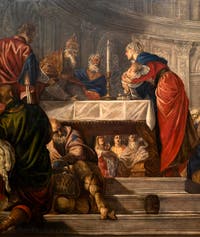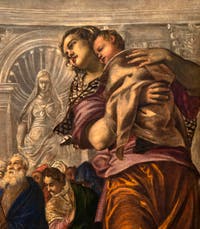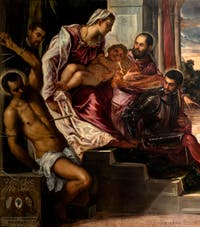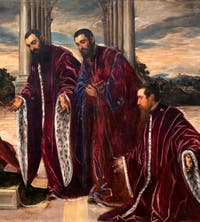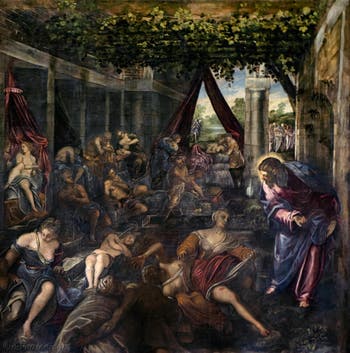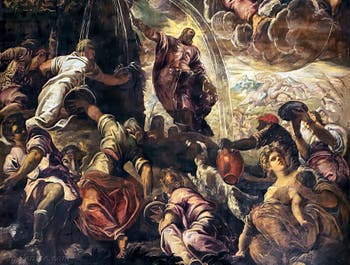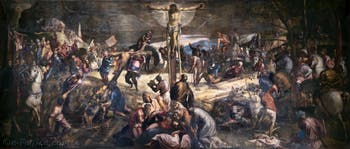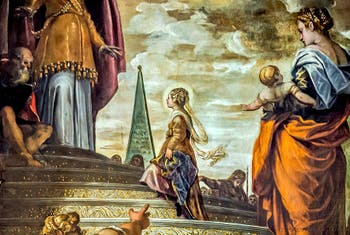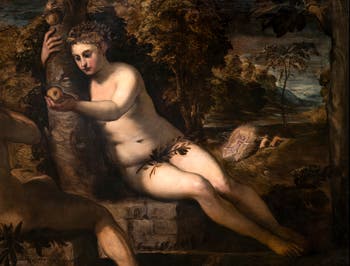Art Painters | Music | Literature | Video | Pictures
Painters Tintoretto | Titian | Canaletto | Fortuny | Albrecht Dürer |
Tintoretto Life and Career | Colors and Fame | Kings Churches Museums
Tintoretto and Maximilian of Austria
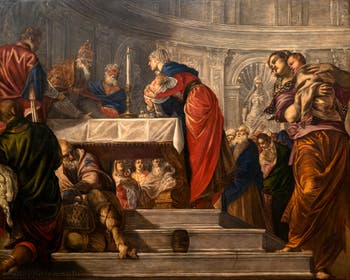
Presentation of Jesus in the Temple
“Marietta was still only sixteen, and yet, what may seem incredible, fame had already carried her name as far as the two courts of Vienna and Madrid...
One day the German ambassador entered Tintoretto's home and, after praising his fine works, said to him with a smile:
- Now, Lord Robusti, it is in the name of His Caesarian Majesty that I have to speak to you.
Emperor Maximilian II, my master, invites you and your two children to Vienna.
He thought that all the talents united in your happy family would be the ornament of his court.
Presentation of Jesus I don't yet know on what terms; but I can tell you in advance that the greater your selflessness, the more magnificent its terms will be.
- My lord," replied Tintoretto, "the kindnesses of His Caesarian Majesty fill me with gratitude; the memory of them will remain engraved in the depths of my soul as long as I have a breath of life; but it is impossible for me to comply with the Emperor's wishes.
I have never left Venice, and it seems to me that if I lost sight of these monuments, these palaces where its history is written, I would leave behind me my ideas, my eyes, all my senses, and, consequently, my genius; your master would only have the shadow of Tintoretto at his court.
- I understand your reasons," continued the ambassador. At your age, it is not easy to break with one's habits; but your children...
- My children! Interrupted Tintoretto, turning pale, if there were a prince powerful enough to separate me from them, that prince would have the power to make me die.
Presentation of Jesus - Do not be alarmed, Lord Robusti; my master only wants your good and your happiness. I hope you will consider his proposals.
- May Your Excellency deign to excuse me; if my will were to change, my heart would have to be stolen to give me another.
Maximilian's envoy insisted again, but he could get nothing.
The fire in the Ducal Palace, which the following year destroyed the paintings in the Great Council and Senate rooms, provided so much work for the painters of Venice that Tintoretto could not have left, even if he had wished to.”
Paul de Musset - A picturesque journey through Italy 1855
Tintoretto, invited by King Philip II of Spain
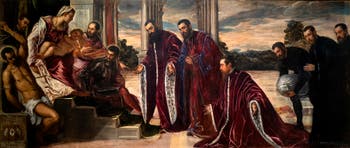
La Madonna dei Tesorieri
“Some time later, the Spanish ambassador having learned of Master Robusti's refusals, did not venture to repeat the same proposals as Maximilian's envoy.
He followed a more skilful course, addressing the Council of Ten to ask for its intervention.
The Council, which then had the desire to be agreeable to King Philip II, promised to make an attempt.
La Madonna dei Tesorieri There was great excitement in the house of Tintoretto, when a fante, that is, an agent of the terrible tribunal, was seen arriving, bearing a summons to appear before the head of week.
Jacques Robusti, all business ceasing, ran to the Ducal Palace.
The excellent Lord Capo called him my son, and coldly advised him to leave for Madrid, where a flattering welcome and such favour awaited him, that this situation would put him in a position to render good services to the republic, since he would have, through his talents and the graces of his daughter, the friendship of the queen and the ear of the king.
Master Robusti threw himself at the Lord Chief's feet and begged him not to take him away from his homeland and his work.
The most excellent lord remained motionless, as if he had been made of marble, and repeated, in the same terms, that his dear son would do well to leave.
La Madonna dei Tesorieri - Well," exclaimed Tintoretto, rising to his feet, "since the Council of Ten, guardian of our laws and protector of the right of cittadinance, wants to exile one of its children, I will leave the States of the Republic, but I will stop at the first village.
Every day I will come to the border and stretch out my arms towards ungrateful Venice, and passers-by will tell you that they have seen Tintoretto sitting by the roadside, sadder and more unhappy than Belisarius.
Apparently the sternness of Lord Capo was only a borrowed mask, for he suddenly softened: a sort of tear slipped between his eyelids, and the sound of his voice altered as he answered:
- Kiss me, my son. You are a citizen of Venice, and free to stay. An artist in love with his proud homeland, as you are, cannot be exiled.
We will offer a gift of oriental fabrics and precious stones to the Spanish envoy, and, immediately afterwards, he will find of his own accord that the envy of the king his master is greatly diminished.”
Paul de Musset - A picturesque journey through Italy 1855
The Studio of Jacopo Robusti Tintoretto, the Ca' Tintoretto
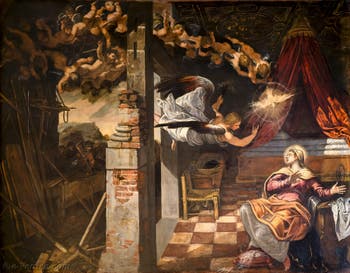
The Annunciation Tintoretto's best-known disciples were his children: Domenico, Marco and Marietta.
“Among his pupils, none went further than Domenico Tintoretto, his son.
He imitated his father's manner quite well.
There is a great resemblance in the faces, in the colouring and in the general agreement.
But Dominique has a misfortune.
When any work of his shows more talent than the greater part of those he has done, either it is attributed to his father, or it is suspected that his father helped him.”
Stendhal - School of painting in Venice
Tintoretto had many disciples. These included the Flemish Martin de Vos anisi and Franceschini, who mainly painted the landscapes in his pictures.
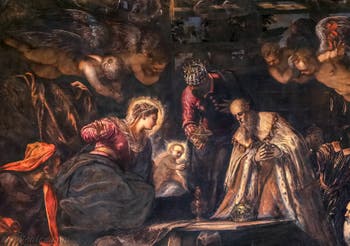
The Adoration of the Magi Fialetti, originally from Bologna, also worked with him.
Rottenhamer, originally from Munich, had gone to perfect his skills in Rome and then in Venice, adopting the maxims of Tintoretto.
It is not known whether he received lessons from the master in person, but there were enough works available to do so.
He then went to England, where he achieved fame.
Domenico and Marco Robusti had inherited their father's workshop. They later passed it on to their German-born brother-in-law Sebastian Casser.
Ottavia Robusti had in fact married Sebastian Casser to keep the family business going.
And before their father's death, her brothers had made her promise that “if it seemed to me that the said Sebastiano behaved well in painting, I should take him as my husband, so that, by his virtue, he would maintain the name of Ca'Tintoretto.”
Tintoretto: 100% Venetian!
“Tintoretto, whose almost entire oeuvre is in the City of the Doges. You wouldn't suspect what Tintoretto is worth if you hadn't been here.
He resembles Michelangelo in terms of originality and energy.
Titian, his master, was almost jealous of him.
The Probatic Pool In Venice, in the church of the Madona dell'Orto, you must see these enormous paintings by Tintoretto; the Adoration of the Golden Calf, the Last Judgement.
They include several hundred feet of paint, thousands of characters, an unprecedented outpouring of imagination and genius.
Tintoretto's mind is like a volcano, always full and erupting. His canvases cover entire churches.
The masterpiece of this incomparable artist is his St. Mark, from the Academy.
Tintoretto gave me some of the most beautiful moments of my life.
I couldn't get enough of contemplating his works.
You're always surprised when you see his paintings.
Don't miss his paintings for the school of San Rocco (Scuola di San Rocco)
Tardieu - Three months in Venice 1884
“Tintoretto! One is stunned, crushed, at the sight of the countless, immense canvases by this indefatigable and robust master (his name was Robusti, after all).
Moses gushing water There is, in one of the galleries of the Ducal Palace, in Venice, a painting which fills the whole back of the room, and which represents Paradise, seventy-five feet long by thirty high.
It is the largest canvas known, and it is not a mediocre painting: the heads, the bodies, the attitudes, the expression, the elevation, the colour, everything is great, noble and beautiful; no emptiness; no filling in, no carelessness or traces of fatigue.
There's only one thing you'll regret when you see this prodigious work of art: not having enough time to look at it carefully and analyse it, because the artist had the time to paint it! And he painted it in his old age!
And it's not just this formidable composition that causes you profound astonishment.
Crucifixon In the same room, here are two, three, four other large paintings by the same Tintoretto, canvases of twenty, twenty-five feet, great pages of history; and here again is a whole palace and church, Saint-Roch, which are filled and decorated with superb paintings by this Tintoretto.
And there are still some in several other churches; and there are some scattered in I don't know how many towns in Italy; and we even have some in Paris, but which, after these great machines, as we now call these immense productions, seem like toys, amusements and relaxations of this prodigious artist, the first of the Venetian painters, when he wants to do well.”
E. Balleyguier - Modern Italy 1886
Born in Venice, Tintoretto spent his entire life there serving it, deploying all his energy to embellish it.
Most of his paintings remained in Venice, so you have to come to Venice to appreciate a full-colour, life-size Tintoretto!
Tintoretto: Presentation of the Virgin in the Temple
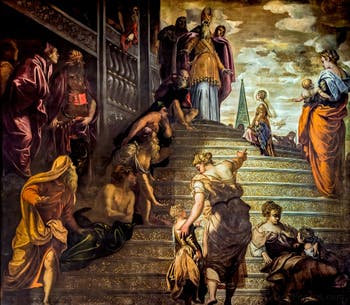
The Presentation of the Virgin in the Temple
Tintoretto and the church of the Madona dell'Orto
Tintoretto was buried in the chapel, along with two of his children: Marietta, who often accompanied him, and Domenico, who worked with him.
But he is still just as present through the works he painted between 1560-62: The Miracle of Saint Agnes; Moses Receiving the Tables of the Law and The Hebrews Preparing the Golden Calf.
He had decorated the inside of the organ doors with The Appearance of the Cross to Saint Peter and The Beheading of Saint Paul.
Next to the organ is the large canvas entitled The Universal Judgement admired by the composer Gian Francesco Malipiero. This vision was a source of inspiration for his Missa pro Mortuis, which he composed in 1938.
The Presentation of the Virgin at the Temple (4.30m x 4.80m)
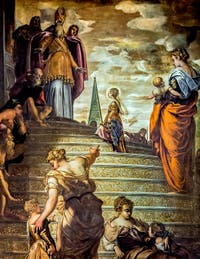
Presentation of the Virgin This work decorated the shutters of the organ. The two vertical panels that made it up were joined in the middle.
It obviously recalls “The Presentation of the Virgin in the Temple” by Titian, painted twenty-six years earlier to decorate the Albergo of the Scuola Grande della Carità (now the Accademia), where the grandeur of the setting, the importance, the attitude of the figures present, and the solitude of the little girl in the middle of the grand staircase underline the solemn and exceptional nature of the event.
Here, the viewer stands at the foot of a magnificent staircase decorated in fine gold, whose exaggerated perspective gives it impressive dimensions even though it has only fifteen steps, fifteen steps corresponding to the fifteen Canticles of Ascent sung by the pilgrims who went up in procession to the Temple in Jerusalem (Old Testament: Psalms 120 to 134 inclusive).
Let's not forget that this painting decorated the organ shutters, and that Tintoretto loved music!
The psalm 130 could illustrate the scene, and announce Mary's future role:
“From the depths I call to you, Yahweh;
Lord, hear my voice!
Let your ears be attentive to the voice of my supplications! [...]
The Presentation of the Virgin in the Temple I wait for Yahweh, my soul waits,
And in his word I hope.
My soul waits for the Lord,
More than watchman in the morning, watchmen in the morning.
Let Israel hope in Yahweh,
For with Yahweh is faithfulness,
Redemption abounds with him.
It is he who will free Israel from all its iniquities. From all her iniquities.”
And we imitate the Virgin:
Starting from the left at the foot of the staircase, following the swivel of the man in full light and all those at the edge of the staircase, moving to follow what is happening there, while in the foreground a little girl hesitates to climb the steps, encouraged by her mother who leans towards her and gently pushes her, showing her the example of little Mary who is already approaching the high priest.

The Presentation of the Virgin in the Temple We join her as she climbs the last few steps separating her from this grave and respected man, who is as impressed by the purity of soul illuminating this child's face as the people from all walks of life who follow her attentively with their eyes.
The sensation of movement is created by the way the eye follows the upward curve of a spiral, beginning at the bottom with the rotation of the man's bust to the right, passing by the little girl and her mother and, following her arm under the light enhanced by the gold of the staircase, here is Mary ascending, turning to the left to join the priest who is waiting for her, standing on the fifteenth and last step.
Such would be the luminous spiral of faith rising towards God for those who follow Mary, the future mother of Christ.
The symbolic richness of this work is enhanced by the richness of the colours and the variety of costumes worn by the figures, whose faces reveal so many different personalities.
Michelangelo himself would not deny the superb woman showing the Virgin to her daughter.
Note also the magnificent hairstyles of these women and their daughters, which are in perfect harmony with the splendour of the sacred steps.
Tintoretto: The Last Supper at San Giorgio Maggiore
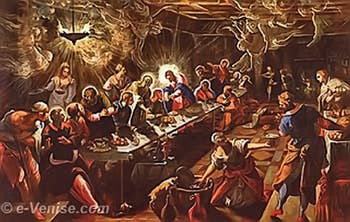
Tintoretto The Last Supper San Giorgio Maggiore
Jacopo Robusti known as Tintoretto in the churches of Venice
Works by Tintoretto can be found in many of Venice's churches.At the church Santa Maria del Giglio is The Four Evangelists.
At the church of la Salute he painted The Wedding at Cana.
At the church of San Marcuola he painted, in 1574, The Last Supper.
The church of San Cassiano, meanwhile, has The Resurrection of Jesus with Saint Cassian and Saint Cecilia playing the organ, behind the high altar. Incidentally, this is one of the few works by Tintoretto in which musical instruments are depicted.
Church of San Giorgio Maggiore - The Last Supper (3.65 m x 5.68 m)
This canvas, painted around 1592-94, is thought to be the last version of the Last Supper by Tintoretto.A large room in a Venetian interior lit by a lamp, the shape of which is reminiscent of a bird.
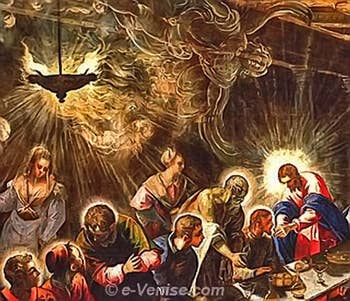
Tintoretto The Last Supper - San Giorgio Maggiore Its light radiates in an unreal way and its smoke merges with ectoplasms of angels floating above the guests.
The luminosity of Christ's halo both opposes and complements this light, which is powerful enough to highlight the bizarre shadows of the guests and intensify the colours.
As in The Last Supper at the Scuola di Rocco, the perspective here again defies the laws of physics: the long table rotates to clearly show the attitudes of the apostles during the last meal shared with Jesus, when he tells them that one of them will soon betray him.
All eleven apostles are lined up on the same side of the table as Jesus; opposite them a lone man, dressed in red and without a halo, does not seem very comfortable.
This is complemented by the realism and naturalness of the protagonists' attitudes: the servants are busy and bustling around the guests, who are chatting and asking animated questions.
They move, they turn, their arms and hands work, while the Apostles are no longer interested in the food on the table.
This subtle blend of realism and pictorial imagination shows us the irruption of the metaphysical and religious realm, with its share of questions and doubts, into the known and familiar real world, where everything seems assured.
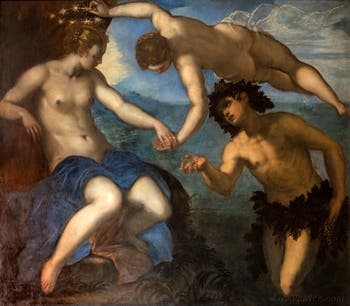
Arian, Venus and Bacchus
Tintoretto and the Ballot Room in the Doge's Palace
“I'm also considering a few portraits of doges; one among them, by Tintoretto, who seems ready to come down from the frame and talk to you because he's so alive.”
Louise Collet - The Italy of Italians 1862
Jacopo Robusti in the Anticollegiate Hall of the Doge's Palace
In addition to the impressive “Paradise by Tintoretto” which can be found in the Grand Council Chamber of the Doge's Palace, four paintings by Tintoretto are also present in the Anticollegiate Hall of the Doges' PalaceThey deal with mythological subjects and celebrate the unity and glory of Venice.
Foreign ambassadors were ushered into this waiting room, and could meditate at leisure on the message suggested.
Tintoretto had completed this cycle in 1577: The Forge of Vulcan with the Cyclops; Mercury and the Graces; Pallas Athena drives away the god Mars; Arian, Venus and Bacchus.
Arian, Venus and Bacchus (146 cm x 167 cm)

Arian, Venus and Bacchus Ariadne, abandoned on the island of Naxos, was surprised by Bacchus, crowned by Venus and admitted among the gods.
Tintoretto depicted Ariadne timidly reaching out to receive the nuptial ring from the hands of a Bacchus full of tenderness and respect.
Venus, light and splendid, helps by crowning Ariadne and accompanying the hand that is about to receive the ring.
The colour and curves of the nudes leave an incredible impression of lightness and purity. And these hands, coming together against a backdrop of sea and sky, are extremely delicate.
Here Ariadne symbolises Venice, born of the sea like Venus, favourite of the gods and free, crowned queen of the seas.
The allusion to the Doge's annual wedding ceremony with the sea is obvious.
Tintoretto at the Accademia Gallery in Venice

Tintoretto, Adam and Eve
Tintoretto in the Galleries of the Accademia
At the Accademia Museum are works by Tintoretto illustrating the life of the Virgin Mary, painted from 1534 to 1538 for the Scuola della Carità.As well as works relating to the golden legend of St. Mark.
“Taine said it: for Tintoretto, “a body is not alive when its plate is motionless” the Miracle of St. Mark is the very miracle of movement.
This flying, plunging figure, this ardent, realistic scene, has been appreciated and described in enthusiastic pages by our greatest art critics.
It is, along with Titian's Assumption, and P. Veronese's Meal at Levi's, the Academy's greatest masterpiece. Anyone who has seen it cannot forget it.
Tintoretto, Adam and Eve On the same wall, we again see Cain and Abel, Adam and Eve, powerful, living figures that fulfil the famous formula that the master had written on the door of his Studio: “The colouring of Titian and the drawing of Michelangelo”.
Adam and Eve also has a superb landscape, grandiose and extremely evocative, in the aerial part of which we catch a glimpse, as it were, of a luminous projection, an apparition, of our first parents, their backs bent and fleeing, under the searing threat of the angel...
Stop now in front of The Adulterous Woman, placed in the middle of a room, on an easel: the subject is interpreted with charming grace, in a spirit of modernism and familiarity.
The trio of Jesus, the woman and the old man who supports her is entirely amiable. Jesus is gentle in his forgiveness, and the woman, it must be said, does not look sorry, nor very repentant.
She is a resigned woman who lets herself live; she is a woman, and therefore weak.
Tintoretto, Adam and Eve Who knows what pitfalls have been laid in store for her! She, who seems without malice, why did she sin? Come on, let's stop thinking about it!
The colouring here is remarkably beautiful. Tintoretto is undoubtedly a colourist on a par with the greatest.
If, in his vast compositions, which had to undergo a certain amount of alteration more than others, there are parts that seem black, we cannot reproach him for contrasts, slightly dark spots that, despite everything, have remained transparent and fluid.
In these tones that time has pushed a little to excess, there is still a background of air and light from which emerge, softly and strongly, like clear, vibrant notes, the bodies of supple white flesh, pulsating with life.
The landscape itself, in Tintoretto's work, retains these precious qualities.”
Léopold Gironde - Memories of Italy 1907
Tintoretto Life and Career | Colors and Fame | Kings Churches Museums
Painters Tintoretto | Titian | Canaletto | Fortuny | Albrecht Dürer |
Art Painters | Music | Literature | Video | Pictures
Back to Top of Page


